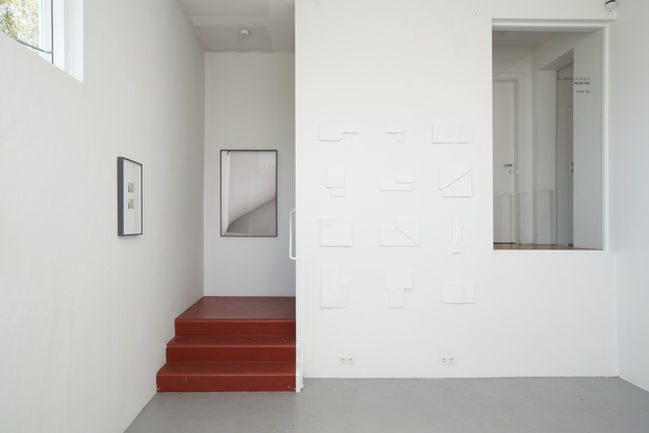Irene
Hrafnan//

HLIÐRUN / PARALLAX
GRYFJAN, ÁSMUNDARSAL. 2023
Parallax. Parallax of concepts or objects, of time, of historical context. Parallax of power positions. Parallax of gender. Parallax of social status, language, perception, experience.
Parallax of a house.
When Gunnfríður Jónsdóttir and Ásmundur Sveinsson divorced, they divided their house at Freyjugata 41 in two by drawing a line through it lengthwise. Gunnfríður got the rear part of the house, while Ásmundur the front spaces and the exhibition hall. The division of the house created boundaries that not only redefined their relationship but also people's relationship to the space. The dividing became apparent in walls, locked doors, and even more subtle delineations. The dissection of space alters the perception and requires adaptation and transformation of physical and mental spaces. The intervention most likely led to rearrangement of furniture and lighting, thus impacting their interaction with the space. There is a certain duality inherent in the idea of dissecting a house into two parts, opposing elements that arise from this architectural intervention. The duality refers not only to separation but also to cohabitation and interaction of two opposing factors.
Corridors and staircases serve as connections between the body and other spaces of the house, possessing inherent rhythm and time. Initially, these spaces served as connections between the front and rear parts of the house, as well as between rooms and floors. However, over time, doors and walls were closed on each level. In their form and substance, they also reflect the body in a material way, with outlines that bear witness to the coexistence of the body and the structure. Curves and shapes of staircases, resembling human form, could, in a western dualistic manner, be considered feminine, as the mind and body have mistakenly been presented as opposing pairs, the mind being masculine and the body being linked to the feminine. However, the body is not a gendered being but rather a perceiving entity or sensory organ. Curves and flowing lines of staircases evoke a sense of flow and natural rhythm, mirroring the movement of the body ascending or descending. Directional lines within the staircase denote movement in a specific direction, and the shapes guide the eye and body, creating a sense of narrative within the space. The layout of rooms shapes our gestures and influences our bodily posture, as if the geometry itself becomes a collaborator in the choreography. Unlike corridors and staircases, which are ruled by movement and time. These spaces are static, not unlike sculptures that, like buildings are fixed structures. Motionless bodies at rest. Bodies where the distance between two points never wavers, and each body part, each space, and each room becomes a location or destination in itself.
Gunnfríður Jónsdóttir (December 26, 1889 - May 15, 1968) was one of the first female sculptors in Iceland. She met Ásmundur Sveinsson in Reykjavík, and in 1919, they traveled to Copenhagen, which marked the beginning of her 10-year stay abroad. Gunnfríður and Ásmundur got married in 1924, and while Ásmundur pursued art studies in Stockholm and Paris, Gunnfríður worked as a seamstress to support them. Gunnfríður was in her forties when she created her first sculpture and lived and worked in the rear part of the house after their divorce, with her workshop in Gunnfríðargryfja. Gunnfríður's works were inspired by women from Icelandic sagas, and among her notable pieces are „Landsýn“ a monument by Strandarkirkja about the miracle in Engisvík, depicting a white-clad woman gesturing to fishermen in distress entering the fjord, and "Landnámskonan“ við Tjörnina," which is believed to be related to the memory of two Icelandic women, Hallveig Fróðadóttir and Auður djúpúðga. The artwork also alludes to the pioneering women in a broader sense, particularly women in the art world, including Gunnfríður herself.















